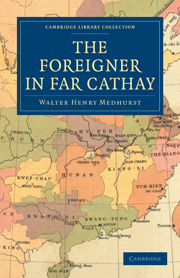Book contents
- Frontmatter
- Contents
- PREFACE
- CHAP. I INTRODUCTORY
- CHAP. II POSITION OF FOREIGNERS IN CHINA
- CHAP. III CHARACTER AND HABITS OF FOREIGN RESIDENTS IN CHINA
- CHAP. IV MISSIONARIES IN CHINA
- CHAP. V CONSULS AND CUSTOMS AUTHORITIES, ETC.
- CHAP. VI CUSTOMS OF THE CHINESE.—SHOP SIGNS
- CHAP. VII ADVERTISING IN CHINA
- CHAP. VIII MANDARIN YAMENS IN CHINA
- CHAP. IX OPIUM SMOKING
- CHAP. X INFANTICIDE
- CHAP. XI EATING AND DRINKING IN CHINA
- CHAP. XII CHINESE SOCIAL INSTITUTIONS
- CHAP. XIII CORRESPONDENCE AND THE PRESS
- CHAP. XIV MODES OF SEPULTURE
- CHAP. XV USE OF THE WRITTEN CHARACTER FOR DECORATION
- CHAP. XVI CHINESE PROPER NAMES
- CHAP. XVII TRAVELLING AND PORTERAGE IN CHINA
- CHAP. XVIII THE CHARACTER OF THE CHINESE
- CHAP. XIX CONCLUDING REMARKS
- APPENDIX
CHAP. XII - CHINESE SOCIAL INSTITUTIONS
Published online by Cambridge University Press: 07 September 2010
- Frontmatter
- Contents
- PREFACE
- CHAP. I INTRODUCTORY
- CHAP. II POSITION OF FOREIGNERS IN CHINA
- CHAP. III CHARACTER AND HABITS OF FOREIGN RESIDENTS IN CHINA
- CHAP. IV MISSIONARIES IN CHINA
- CHAP. V CONSULS AND CUSTOMS AUTHORITIES, ETC.
- CHAP. VI CUSTOMS OF THE CHINESE.—SHOP SIGNS
- CHAP. VII ADVERTISING IN CHINA
- CHAP. VIII MANDARIN YAMENS IN CHINA
- CHAP. IX OPIUM SMOKING
- CHAP. X INFANTICIDE
- CHAP. XI EATING AND DRINKING IN CHINA
- CHAP. XII CHINESE SOCIAL INSTITUTIONS
- CHAP. XIII CORRESPONDENCE AND THE PRESS
- CHAP. XIV MODES OF SEPULTURE
- CHAP. XV USE OF THE WRITTEN CHARACTER FOR DECORATION
- CHAP. XVI CHINESE PROPER NAMES
- CHAP. XVII TRAVELLING AND PORTERAGE IN CHINA
- CHAP. XVIII THE CHARACTER OF THE CHINESE
- CHAP. XIX CONCLUDING REMARKS
- APPENDIX
Summary
Although, as has been stated in a previous chapter, there is no such thing as social intercourse between the Chinese and foreigners, it cannot fail to strike even a cursory observer that they are a sociable people amongst themselves, and that their courtesies are of a most laboured and punctilious character. Visiting, for example, is a serious affair, and has to be conducted in accordance with a conventional code, which prescribes all kinds of formalities varying with the respective positions of the visitor and visited. Cards are extensively used, but of a colour and style far different from what we are accustomed to employ as mediums in the interchange of civilities. The shapes and sizes, moreover, vary considerably with the occasion and the individual. The common plain card used between equals consists of a single sheet of crimson paper about 12 inches long by 4 inches broad, with the surname and name stamped or written in black ink, the more mammoth-like the character the more imposing and respectable. This is generally used amongst officials pretending to some rank or position. A card of about half the size is used by men of inferior rank and commoners, or even by the higher officials where the parties are on intimate terms.
- Type
- Chapter
- Information
- The Foreigner in Far Cathay , pp. 101 - 110Publisher: Cambridge University PressPrint publication year: 2010First published in: 1872

